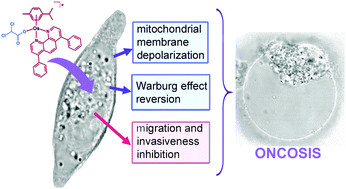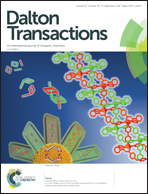Half-sandwich Os(ii) and Ru(ii) bathophenanthroline complexes: anticancer drug candidates with unusual potency and a cellular activity profile in highly invasive triple-negative breast cancer cells†
Abstract
There is an urgent need to discover new, selective compounds to add to the limited arsenal of chemotherapeutics displaying selective toxicity for aggressive triple-negative breast cancer (TNBC) cells. The effect of two, recently developed metal-based half-sandwich complexes [Os(η6-pcym)(bphen)(dca)]PF6 (Os-dca) and [Ru(η6-pcym)(bphen)(dca)]PF6 (Ru-dca) [pcym = 1-methyl-4-(propan-2-yl)benzene (p-cymene); bphen = 4,7-diphenyl-1,10-phenanthroline (bathophenanthroline); dca = dichloroacetate] on triple-negative breast cancer cells MDA-MB-231 is reported. The complexes display selective toxicity in several tumor cells (at submicromolar concentrations), and a prominent effect is observed against highly progressive triple negative breast cancer MDA-MB-231 cells for Os-dca. The lower potency of Ru-dca in comparison with Os-dca is apparently connected with a relatively quick release of the dca ligand due to the hydrolysis of Ru-dca before this complex enters the cells. Remarkably, both Os-dca and Ru-dca reduce successfully metastasis-related properties of the triple-negative breast cancer cells such as migration, invasion, and re-adhesion. The anti-metastatic effects of Os-dca and Ru-dca are associated with their ability to suppress matrix metalloproteinase activity and/or production and reduce the expression of aquaporins. Further detailed mechanistic studies reveal that Os-dca reverses Warburg's effect and oncosis seems to be a prominent mode of cell death that predominates over apoptosis. As such, Os-dca can efficiently overcome the resistance of cancer cells to clinically-used apoptotic inducers cisplatin and carboplatin. The cytostatic and anti-metastatic properties of Os-dca in MDA-MB-231 provide a strong impetus for the development of new metal-based compounds to target hardly treatable human TNBC cells and displaying different modes of action compared to the antitumor metallodrugs in clinical use.



 Please wait while we load your content...
Please wait while we load your content...